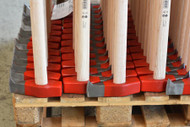
Japanese Garden Tools Vs. American: What’s the Difference?
You may have seen Japanese gardening tools popping up more in stores and online. Sure, they&rs… Read More

The iron axe was brought to New World by its earliest European settlers and traders. It can’t be overstated how important this tool was to the development of the American frontier. There is perhaps no tool that conjures up the proverbial image of fierce independence and the frontier can-do spirit. A must-have for every pioneer, the axe was perhaps even more important than a rifle, as explorers and trappers first populated the east coast, then expanded westward. Town blacksmiths, and then later edge-tool foundries, took the accrued knowledge of European axe making and tailored it to local needs. Soon, the American felling axe carried its own aura of expertise. The felling axe, used for downing trees, carried the lion’s share of the burden of clearing woods for farming and homesteads, and to harvest timber for ships and housing, to burn as fuel, or to profit as a cash crop.
During the heyday of the axe in the nineteenth century, there were hundreds of foundries, and as many different shapes and styles of axe head patterns. Many were named for the area in which they were created or used, including such geographic monikers as Jersey, Hoosier, Michigan, Dayton, Connecticut, Baltimore, and Yankee. There were hundreds of other variations, but many of these venerable patterns fell out of use, after the introduction of the cross-cut saw, a tool which competed directly with felling axes. Today, the patterns of these axe heads live on mainly in the reproduced pages of old catalogs, and only a couple dozen of the most iconic patterns continue to be forged.
Garrett Wade offers many quality edge tools—axes, mauls and hatchets—from a variety of foundries. But one foundry, our closest collaborator, stands out among forges. A third-generation family run business in southwestern Germany that is as obsessive about tool detail and quality as we are. What we love about these tools—primarily the axes, hatchets, and mauls they make for us—is that they hit that sweet spot on the price-to-quality matrix. That is, these hand-forged, edge tools are only marginally more expensive than those mass-produced, yellow-handled offerings found at national superstores, while providing comparable quality to your more expensive, artisanal axes now all the rage. We have found that the value offered by this family-run forge is exceptional, and their experience speaks for itself. Indeed, the foundry will soon celebrate its centenary.
The forge makes a variety of axe styles for us, from the heavy-headed mauls used to split log rounds, to the thinner-bladed, long-handled felling axes of frontier fame, to medium-sized forest axes and smaller, all purpose camp hatchets and tomahawks. The tools are all hand-forged by experienced smiths, and each product is carefully scrutinized along each step of the production process. We collaborate with the forge on all design details, large and small. For example, with the longer and heavier tools, like our Super Splitter Maul, Pro Maul, and Forest Axe, we employ extra thick necks and red steel safety collars to help absorb shock and damage from errant blows. These wayward swings are, of course, a reality when splitting wood, but one wrong blow can split or otherwise damage the handle. A weakened handle is a potential danger because the head could fly off. Another Garrett Wade-brand detail is the bright, fireman’s red painted handle ends on all our tools. From our experience working with axes and hatchets–whether in a campsite, forest clearing, or your backyard log-chore staging area–we constantly use the axe and then put it down on the ground. Wood handles camouflage easily with leaves, dirt, and other branches, limbs, etc., so it’s easy to overlook the axe or hatchet that’s on the ground. This little bit of red color pop helps us more easily spot the mislaid tool.
This factory not only forges the metal parts of our tools but, atypically, also produces the handles. Hickory is the preferred timber used in axe handles, universally acknowledged for its whip quality when swinging. The axe shafts bear a stamp with the inscription, “Orig. USA Hickory,” because American Hickory is incomparable when it comes to tool handles. The heads of all the chopping tools from this forge are secured or “hung” to the shafts with the aid of round “eye ring.” Like many modern German factories, this one is environmentally friendly. For example, they use the sawdust and waste wood of their handle production unit as a fuel for kilns and for heating offices.
It is this kind of open-minded, willing teamwork that helps us create great tools, by refining the forge’s standard templates with small details, into the kind of tools that we ourselves, and our customers, will want to use. There are no egos in this collaboration, only a deeply professional desire to work with like-minded partners, in order to produce the best tools possible, in that fabled tradition of precise German craft. We hope you will check out these exceptional axes, mauls and hatchets, produced in partnership with our German foundry. They offer great value for your money. You won’t be disappointed.